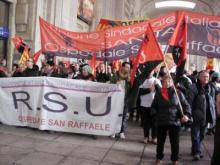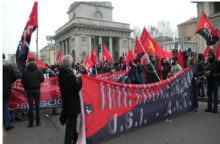Protests and strikes all over Italy on Nov 14
Tens of thousands took part in demonstrations in about 100 Italian towns as part of the 14 November European general strike. Strikes affected many sectors including, amongst others, schools, railways, public transport and healthcare while students demonstrated around the country, leading to fighting with police.
The biggest protests were in Rome, where an estimated 50,000 people joined the demonstrations and which saw bitter fighting between police and protesters. Milan saw three different demonstrations with total attendance at around 10,000. One was from the CGIL (the largest of the mainstream unions), who had also called a four-hour strike for the day. The students held the largest demonstration in Milan, estimated at around 5,000, which also saw clashes with police. Sticks, eggs and flares were thrown at police, banks and an elite private university.

